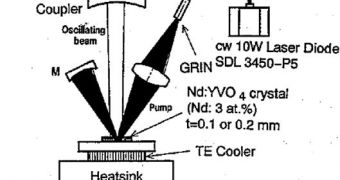Under a new agreement signed with representatives of the US federal government, the Boeing Company now needs to start designing and developing an advanced laser that utilizes a rather new light amplification technology.
The contract, estimated to worth about $4.2 million at this point, spans some 16 months. During this time, the company needs to construct, and preferably also test, a 25-kilowatt high-brightness laser.
This solid-state, electric laser will most likely be based on the highly efficient Thin Disk Laser (TDL) technology, say representatives from the company. They are optimistic that the deadline the contract stipulates will be respected.
Boeing is constructing the device for the High Energy Laser – Joint Technology Office (HEL-JTO), which is a division of the Pentagon. With this instrument, the Office wants to prove that its Robust Electric Laser Initiative program objectives are attainable.
The performances of TDL-based systems have not been so closely investigated until now, and the objectives of the HEL-JTO program call for the development of lasers capable of high brightness and high electrical efficiency.
According to experts at Boeing, lasers currently used in cutting and welding metal parts will provide the company with a good starting point in its endeavor. A lot of the components that will be used in the TDL systems will belong to commercial lasers.
To this, the company will add its own innovations, in hopes that this will lead to the fast development and production of operational versions of the laser system, that the Pentagon could then actually use.
“The Thin Disk Laser project provides a great opportunity for Boeing and the Pentagon to advance the efficiency and performance of solid-state laser technology,” explains expert Mike Rinn.
“As we work the details of this project, we are building on Boeing's industry leadership in the integration of high-power laser devices. Our team is proud to be on the forefront of directed energy capabilities,” adds Rinn, who is the vice president of Boeing Directed Energy Systems.
In essence, TDL lasers are high-power, solid-state directed energy weapons, and they can be used as such in urban environments and in open battlefields. Their primary advantage is that they can strike with surgical precision, limiting collateral damage.

 14 DAY TRIAL //
14 DAY TRIAL //